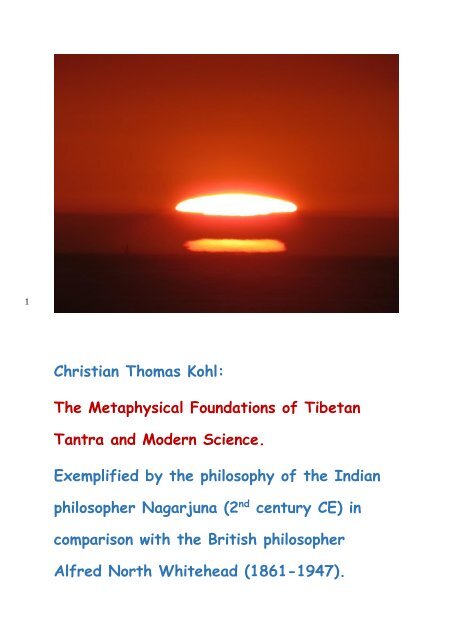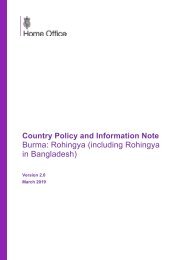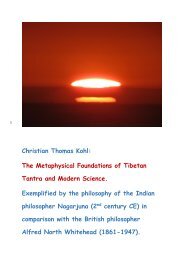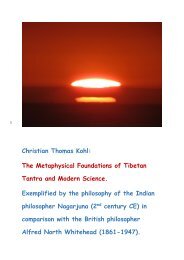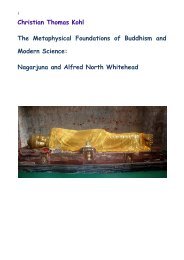Tantra
Create successful ePaper yourself
Turn your PDF publications into a flip-book with our unique Google optimized e-Paper software.
1<br />
Christian Thomas Kohl:<br />
The Metaphysical Foundations of Tibetan<br />
<strong>Tantra</strong> and Modern Science.<br />
Exemplified by the philosophy of the Indian<br />
philosopher Nagarjuna (2 nd century CE) in<br />
comparison with the British philosopher<br />
Alfred North Whitehead (1861-1947).
Abstract.<br />
By the 7th century a new form of Buddhism known as Tantrism<br />
had developed through the blend of Mahayana with popular folk<br />
belief and magic in northern India. Similar to Hindu Tantrism,<br />
which arose about the same time, Buddhist Tantrism differs<br />
from Mahayana in its strong emphasis on sacramental action. Also<br />
known as Vajrayana, the Diamond Vehicle, Tantrism is an<br />
esoteric tradition. Its initiation ceremonies involve entry into a<br />
mandala, a mystic circle or symbolic map of the spiritual<br />
2<br />
universe. Also important in Tantrism is the use of mudras, or<br />
ritual gestures, and mantras, or sacred syllables, which are<br />
repeatedly chanted and used as a focus for meditation.<br />
Vajrayana became the dominant form of Buddhism in Tibet and<br />
was also transmitted through China to Japan, where it continues<br />
to be practiced by the Shingon sect.<br />
This is the usual understanding of Tibetan <strong>Tantra</strong>. With a feeling<br />
of great dismay, I regret to say that this is an understanding<br />
without any foundation. This is nothing more than an exotic<br />
superstition when separated from its metaphysical foundations.<br />
What Alfred North Whitehead tells us about Christianity can be<br />
transmitted with small changes to Buddhism. Whitehead says:
"Christianity would long ago have sunk into a noxious superstition,<br />
apart from the Levantine and European intellectual movement,<br />
sustained from the very beginning until now. This intellectual<br />
movement is the effort of Reason to provide an accurate system<br />
of theology. Indeed, in outlying districts where this effort at<br />
rationalization died away, the religion has in fact sunk into the<br />
decrepitude of failure" (A.N.Whitehead, Adventures of Ideas,<br />
The Free Press Paperback Edition 1967, page 162).<br />
In this short history in images I will present the Metaphysical<br />
3<br />
Foundations of Tibetan <strong>Tantra</strong>. That is mainly the philosophy of<br />
the Indian philosopher Nagarjuna (2 nd century CE) in comparison<br />
to the British philosopher Alfred North Whitehead (1861-1947).<br />
[The end of the abstract]
4<br />
1.Early Buddhist ideas of reality. Three<br />
examples, three images:
5<br />
Reality is like a banana tree. Consider all things thus.
Commentary:<br />
The tropical and subtropical palm like plant that bears bananas,<br />
having very large leaves but lacking a woody trunk.<br />
This is a common example in early Buddhism. We should consider all<br />
things thus. All things are without a solid core, they are<br />
substancelessness.<br />
6
7<br />
A fog
Reality is like a fog. Consider all things thus.<br />
Comment: A fog is also a traditional allegory in early Buddhism. In<br />
a fog everything appears less real, more vague.<br />
8
9<br />
A reflection
Comment: Reality is like a reflection. A reflection is not nothing, nor<br />
is it empty. It exists. There is a reflection in a mirror or in a lake. It<br />
just consists of light, it does not represent a doubling of the material<br />
reality, but pretends to be a doubling. It exists in an intermediate<br />
realm between nothing and material reality. It is like an appearance<br />
that is not itself. We see a cause by its effect. Above all, it is not<br />
tangible. It does not bind us to this world and we can rather liberate<br />
ourselves from our greed for something solid and durable. If we look<br />
at all things like a reflection, we can learn the letting go. That is why<br />
in early Buddhism the reflection was taught. Allegories had been<br />
10<br />
important in early Buddhism.
11<br />
Reality is like a (sunset) mirage. Consider all things thus. Buddha<br />
Sakyamuni
2.Nagarjuna.<br />
Nagarjuna (2 nd century of Common Era) has not only expressed his<br />
ideas of reality in the terms of 'Sunyata' and 'Pratityasamutpada'.<br />
These two Sanskrit terms are in his main work [MMK] nothing but a<br />
summarizing generalization of 25 allegories with which he examined,<br />
depicted and compared reality. The terms sunyata and<br />
pratityasamutpada can be understood as collective terms for what<br />
lies between things. Sunyata and Pratityasamutpada can not be<br />
translated by a single word.<br />
The mainstream European philosophies have not been concerned with<br />
12<br />
relations between things. They have gone completely different ways.<br />
Especially since Plato (428 - 348 B.C.), they have dealt with the<br />
extreme ideas of the absolute or substance, or since René Descartes<br />
(1596 - 1650), in the philosophy of the modern world, with the<br />
extreme opposite: the independent subject. Aristotle (384 - 322<br />
B.C.) the probably most important and influential philosopher of<br />
ancient Greece besides Plato, had formulated a logical principle<br />
according to which a fact either exists or does not exist, tertium<br />
non datur, a third does not exist. It is a mode of thought in a blackand-white<br />
scheme without intermediate areas. It runs like a red<br />
thread through the history of European philosophy and science, from<br />
Aristotle to the present day.<br />
At this point I would like to reject the black-and-white scheme with
a few images representing the third, the intermediate state, using<br />
the example of day and night.<br />
13
14<br />
Black-and-white scheme
3. The evening in pictures<br />
But why pictures? Just a few reasons: Pictures can contain a<br />
freshness that ideas cannot reach. Usually pictures are more<br />
comprehensive than individual ideas, they represent the never<br />
perceptible, not comprehensible whole of things. Since images go into<br />
the blood via the eyes, they offer a deeper certainty than ideas. An<br />
image cannot actually be translated into words without losing part of<br />
the visual experience. The words lack freshness, aesthetics, a<br />
concrete overall impression, diversity and versatility.<br />
15
16<br />
1. The evening.<br />
The evening lies between day and night. It is a transition, an<br />
intermediate state.
17<br />
2. The evening.<br />
The evening connects day and night. It has no existence of its own, in<br />
part it is day, in part it is night.
18<br />
3. The evening.<br />
The evening, hanging between day and night, without any foundation.
19<br />
4. The evening.<br />
"As for passion, it is proven for all things: Neither are they<br />
together, nor are they not together". (Nagarjuna MMK 6.10). This is<br />
also true for day and night. Neither are they together, nor are they<br />
not together.
20<br />
5. The evening<br />
“Quantum entanglement is a very strange type of thing. It is<br />
somewhere between objects being separate and being in<br />
communication with each other” (Roger Penrose, The Large, the<br />
Small and the Human Mind, Cambridge University Press. 2000 page<br />
66).
21<br />
6. The evening.<br />
Day and night are opposites.<br />
Day and night are opposites that seem to be completely mutually<br />
exclusive. Through the evening these opposites are connected to a<br />
unity. "People have chosen two forms of being and have named them<br />
firmly with two different expressions. With this they have of course<br />
committed a fundamental error, namely to separate the two figures<br />
instead of leaving them as one being" (Gadamer/Parmenides)
22<br />
7. The evening<br />
The evening establishes a connection between day and night and a<br />
relationship between day and night.
23<br />
8. The evening.<br />
Day and night are neither together nor not together. The evening is<br />
between day and night. The evening is entangled with the day and<br />
with the night.
24<br />
9. The evening<br />
„The mean between two or more things, theirs juncture, union,<br />
transit, passage, crossing, interval, distance, bond and contact – all<br />
these are mysterious, for they are rooted in the continuum, in the<br />
infinite“. (Vincenzo Gioberti, in: Paolo Zellini, A Brief History of<br />
Infinity, Published in Penguin Books, London 2005, p. 53).
25<br />
10. Evening<br />
„The mean is a union of two diverse and opposite things in a<br />
unity“(Vincenzo Gioberti, Ibid., p. 53).
11. Evening<br />
26<br />
“A courageous scientific imagination was needed to realize fully that<br />
not the behaviour of bodies, but the behaviour of something<br />
between them, that is, the field, may be essential for ordering and<br />
understanding events” [...] “What impresses our senses as matter is<br />
really a great concentration of energy into a comparatively small<br />
space” ( Einstein, A. & Infeld, L. The Evolution of Physics. London:<br />
Cambridge University Press. 1938. pp. 257, 311/312.)
27<br />
12. Evening<br />
Two keywords of Whitehead’s philosophy: Passage [movement from<br />
one place to another, change or progress from one process or<br />
condition to another, transition, a hall or corridor that is an entrance<br />
or exit or onto which several rooms open. Transition: a passing from<br />
one condition, form, stage, activity, place, etc. to another, the period<br />
of such passing, a word, phrase, sentence, or group of sentences that<br />
relates a preceding topic to a succeeding one or that smoothly, not<br />
crudely, connects parts of a speech or piece of writing. Webster's<br />
New World Dictionary. Adventures of Ideas, page 236].
4. Conclusion<br />
Our study's conclusion confirmed our metaphysical assumption. We<br />
have seen 12 images where the black-and-white scheme of Aristotle<br />
not defensible. There is no separation but a transition between day<br />
and night. There is no independent day and no independent night and<br />
we might consider all things thus. Things are connected like the day<br />
and the night. They are not properly one and not properly two bodies.<br />
As Penrose has mentioned for quantum entanglement: “It is<br />
somewhere between objects being separate and being in<br />
communication with each other”.<br />
28<br />
These ideas of reality are the metaphysical foundations of Tibetan<br />
<strong>Tantra</strong>. They give you the empowerment to become detached from<br />
the entanglement to this world. Separated from such a relational<br />
view the tantric ritual gestures and initiation ceremonies and<br />
mantras or sacred syllables are superstitions or hocus-pocus.<br />
The aim of the faith when it is separated of a metaphysical<br />
foundation is to gain influence over all kind of power. It is pure<br />
worldly greed for power. In complete contrast, Buddhist philosophy<br />
wants to liberate us from any greed for power. Buddhist philosophy<br />
gives up any claim to power. It’s like fire and water. Fire and water<br />
are not compatible. Buddhist philosophy means liberation from power.<br />
Superstition and the Buddhist philosophy of liberation cannot be<br />
united.
Without a philosophical foundation, the tantric faith is in danger of<br />
sinking into superstition and decaying like a house of cards.<br />
The direction and foundation of Buddhist philosophy is to let go of<br />
attachment to power, profit and prestige of this world.<br />
Without these philosophical foundations, we then find ourselves at<br />
the level of sorcery. At this level, every spectator knows that the<br />
sorcerer cannot perform magic [magic: the use of charms, spells, and<br />
rituals in seeking or pretending to cause or control events, or govern<br />
certain natural or supernatural forces]. He can only deceive [deceive:<br />
to make (a person) believe what is not true].<br />
29<br />
[Superstition: 1. any belief or attitude, based on fear or ignorance,<br />
that is inconsistent with the known laws of science or with what is<br />
generally considered in the particular society as true and rational;<br />
esp. such a belief in charms, omens, the supernatural, etc. 2. any<br />
action or practice based on such a belief or attitude. Hocus-pocus:<br />
meaningless words used as a formula by conjurers. Webster’s New<br />
World Dictionary]<br />
Christian Thomas Kohl<br />
Email: kohl2018@gmail.com<br />
Site: http://ctkohl.googlepages.com


